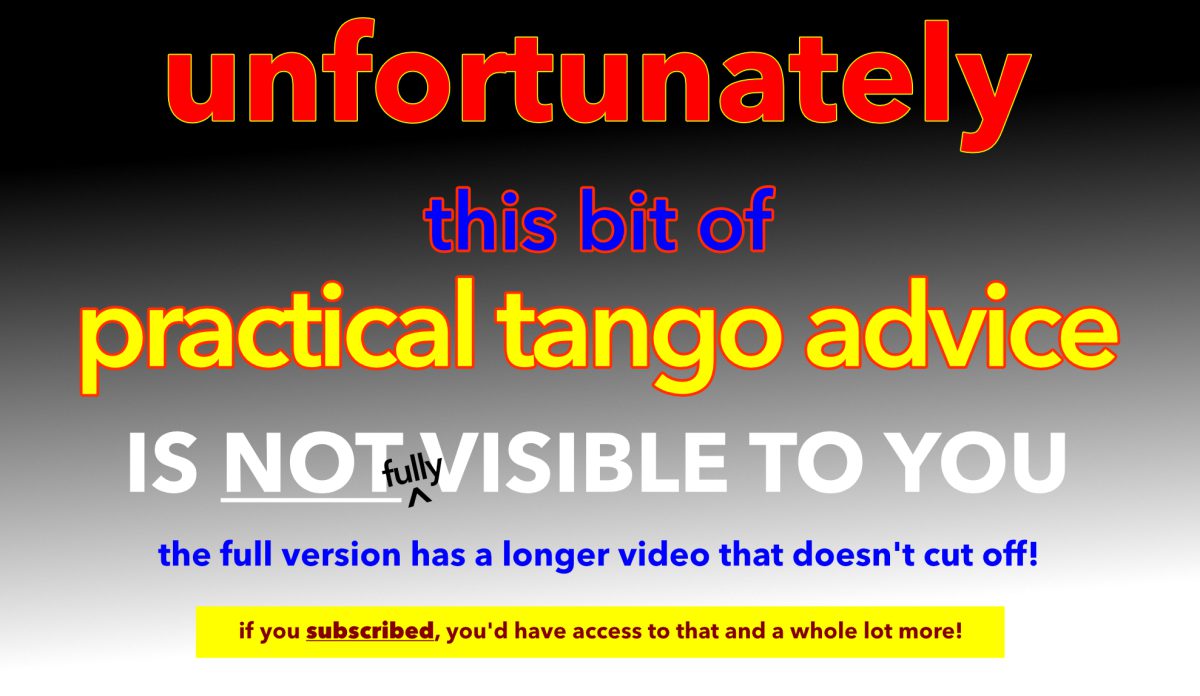Floorcraft 106 – The Turn. Let’s get a few things out of the way first and foremost: When talking about ‘The Turn’ as it regards Argentine Tango there’s only one type of turn that comes to people’s minds. You can thank Gustavo Naveira & Fabian Salas for that one. Their ideas became canon and they literally supplanted a venerable turn that had been in use for almost 70 years before the Molinete/Giro structure became the dominant turn. Just as a side note, the turn that was supplanted? The Milonguero Turn, which in our opinion is the more elegant and useful turning element in Tango. What’s a Milonguero Turn ? Look at the version from our YouTube series: 10 Second Tango. Secondly, there are 8 types (see below for the list of types of turns) of turns in Argentine Tango in case you were interested, so it’s inaccurate, as far as we’re concerned, to say “The Turn”. It would be more appropriate to say “The Follower’s Molinete to the Lead’s Giro” Structure. Yes, it’s a mouthful, but it’s an accurate mouthful and one that is far more precise, especially when you consider that there are 7 other types of turns. 😉 That said… Today’s bit of Floorcraft, remember this is a topic about Floorcraft? This topic deals with ‘The Turn’ or to be more accurate the Follower’s Molinete to the Lead’s Giro in relation to Floorcraft. And the reason we’re yapping about it here, is not only is it the staple of the dance, but Argentine Tango has become a ‘turning’ dance, it is no longer a walking dance, but one based on the turn. Even though the dance is all about the walk, the foundation is walking, the walking methodology has been replaced by the Follower’s Molinete to the Lead’s Giro. So not only is it important to recognize it, but in fact, face the reality that you will spend oodles of time in turns so you may as well understand why this stuff is relevant to Floorcraft! So without further yapping, Tango Topics Practical Tango Advice presents Floorcraft 106: The Turn.
What does “The Turn” mean ? The turn, as was said, refers to the Follower’s Molinete to the Lead’s Giro. However, there are three things that we want to pay attention that can affect our turns, and thereby affect our Floorcraft choices.
1.) The first of those things is the “Continuous Turn”, this is where a turn will go on beyond a single revolution but instead, due to the fact that the Ronda isn’t moving, you will more than likely be engaged in a series of multiple turns of the same variety. Or in this case, the Follower’s Molinete to the Lead’s Giro variety, over and over and over again.
2.) The second of those things is what we call a “Broken Turn”, this is where the Turn is interrupted and usually the same turn is inserted that goes in the opposite direction, OR (and this is not in the video) it could be any one of the other seven types of turns in Argentine Tango that is inserted into the turn structure as a way to break the sameness of the turn to add a little variety perhaps.
3.) The third thing we need to be conscious of is Space, Distance, and Time. Time, in this case, refers to the Time signature of the music. We need to be aware at all times of how fast or slow we are going and matching our movements to the beat of the music. This is NOT shown in the video for obvious reasons. Space, in this case, refers to the amount of space that we’re taking up with our movements. Distance, in this case, refers to the distance between ourselves and the next couple ahead, behind, or next to us on either side.

These three things comprise “The Turn” with regards to Floorcraft.
If for no other reason than to educate yourself, the 8 Types of Turns in Argentine Tango are as follows: 1.) Walking Turn. 2.) Media Luna. 3.) Calesitas. 4.) Rock Steps (and their resolutions). 5.) Linear Ocho Cortado/Circular Ocho Cortado. 6.) Colgada Turns/Single Axis Turns. 7.) Molinete/Giro Structure. 8.) The Milonguero Turn.
The reason we point this stuff out is that when it comes to the broken turn that any one of the noted turns above could be inserted into the turn structure as a way to vary it but doing so creates unintended variables and variations that you may not necessarily account for going into and out of them. And as a result, it creates slippage in the partnership.
Why is this stuff important ? It’s important because how we manage the Follower’s Molinete to the Lead’s Giro, and how we execute these things has a very real world, palpable consequences when the execution for either role is less than desirable or sloppy. And those real-world consequences are that the turns can become unwieldy thereby taking up more physical space and distance between the couples that are around us. The fact that it’s a continuous turn has consequences, or a broken turn has the same consequences. Those consequences usually manifests itself as ‘slippage‘ in the partner’s alignment with each other.

